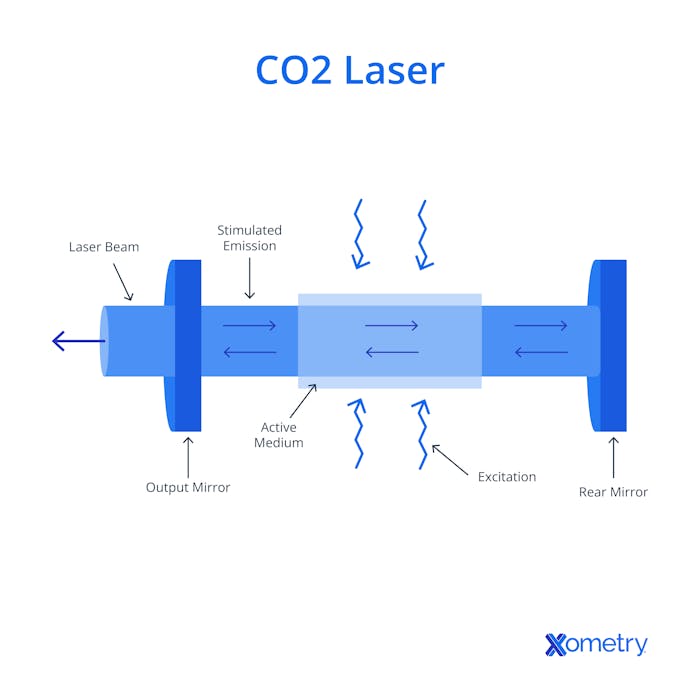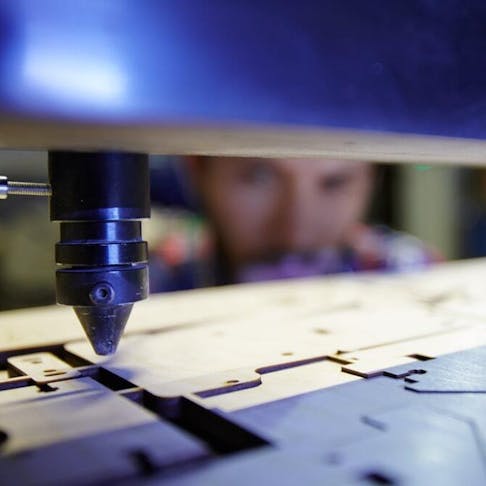Wood is a great material for building projects—it’s tough, flexible, forgiving of mistakes, and is well suited to laser cutting if the right material is chosen.
In fact, Xometry offers a high quality Wood Laser Cutting service - it's something a lot of our customers requested, so we added it a few years ago. We offer a variety of wood materials for cutting including Cherry Hardwood, Hardboard, MDF, Poplar Hardwood, Red Oak Hardwood, Uncoated Wood Laminate (Plywood), Chipboard, and Birch.
Both CO2 and fiber lasers will handle wood cutting well, although many users report the best results with CO2.

This article will discuss the four best woods for laser cutting, and provide tips on laser cutting wood.
1. Softwoods
Typical softwoods (lumber from conifers such as pine and spruce) are generally hard to laser cut. The alternating soft-tough grain structures can cause serious cutting problems, as can resin and knots. Softwoods of the highest quality can usually be sourced in any thickness, ranging from flexible 1/16” sheets.
Most desktop laser cutters can cut smooth-grained 6 mm or ¼” sheet softwood with no problem. It is also possible to find “normal” pinewood that is more consistent in structure and knot free.
2. Veneers
Veneers come in the widest range of woods, from Abura to Zelkova. Not all of them are ideal for laser cutting, however. As a rule, veneers tend to be around 1 mm or 1/16” maximum thickness, and they will almost all cut quite cleanly, with low power and high cut rates. Laser cutting offers a range of advantages, including no chipping/flaking, easy-to-cut very fine curves, no clamping required, splinter and fiber-free cut edges, and the last cut is as perfect as the first.
The precision with which veneers of many kinds of wood can be prepared offers a great way to make beautiful things. But, veneers are also great source materials for making strong, functional objects by lamination and smart choice of grain alignments.
3. Hardwoods
Hardwoods such as oak, walnut, and cherry require high laser powers for successful cutting. Their dense structure, however, results in very clean and smooth cuts. Engraving hardwoods can result in similarly crisp and clean marks with great contrast. Laser cutting and engraving wood will produce hard-to-remove dust from the cut sample. Painters’ tape acts as a great protective barrier and offers no resistance to the laser cut. It is recommended to use your blower, with one nozzle directed at the optics and one at the cut.
Hardwoods can be sourced in a wide range of thicknesses but may need multiple passes to cut. In general, a 45 W laser at full power and a slow feed will cut ¼”-thick slices of most hardwoods. Two passes of a 90 W laser will similarly work for ½” thickness.
You can also get hardwood cut by Xometry through our instant quoting engine. Xometry offers quotes on Cherry Hardwood, Hardboard, MDF, Poplar Hardwood, Birch, and Red Oak Hardwood.
4. Plywood
Plywood is a broad group of materials that encompasses rough construction ply, hardwood marine ply, flexible birch modeling ply, and “stout heart” boards. Plywood laser cutting offers interesting aesthetics, high-strength parts, and a low material price. It is useful for both appearance and functional products. Xometry offers laser cutting of Uncoated Wood Laminate (Plywood).

A plywood laser cutter needs high laser power settings for clean cuts, and multiple higher-speed cuts to minimize edge burning on thicker sections. A CO2 or diode laser of 40–100 W is widely recommended. This should give good results up to ½” thickness with two or more passes, depending on laser power. Higher power is beneficial, as it allows faster feed and reduces the heat-affected zone (HAZ).
Lower-power laser cutters for plywood can still produce good results. A 20 W laser can cleanly cut a typical ¼” plywood using three passes at 50 cm/min if it has a fairly strong blower to clear the cut for the next pass. Blower assist is important to keep the cut and optics free of dust, particularly in multi-pass cutting. For surface protection, PVC-free painters’ tape is a useful aid to clean surfaces along the cut line. The frequency of light that fiber lasers emit is slightly too high for most plywood, and as a result, misses the absorption spectrum necessary for a high-quality cut.
Things To Consider When Choosing the Best Wood To Laser Cut
There a range of factors to consider in selecting wood for a project, including:
- Thickness: Thicker wood requires higher power or more passes. Without a strong blower, repeat passes may not work well.
- Density: Harder and denser materials require more power, more passes, or both.
- Engraving: Softer woods produce less contrast in engraving.
- Oil Content: Oily woods like teak can cut messily, suffering a lot of staining in the HAZ.
- Price: Higher quality woods cost more.
- Laser Type: Fiber lasers provide slower and poorer quality cutting and require more passes for the same material thickness as CO2.
How To Check the Differences Between Woods for Laser Cutting
Checking the differences between woods for laser cutting can be done by reading about others' experiences with laser woodcutters. Learn about what does and does not work for them. Read the forums for your machine, as these will likely include the most informative and relevant experiences.
Another checking method is to get some scrap wood samples and try some pattern cuts and engravings. You will find plenty of examples of good cut patterns and machine settings to suit various materials on the internet and from the manufacturer themselves. This learned experience will calibrate your understanding of your own machine's capabilities with the materials you wish to select.
Performance differences will often show up very clearly in the test samples—providing you with a great reference for material types that work well and cutter settings that give good results. Excluding the materials that don’t work well for you will prevent you from making mistakes.
What To Look For When Choosing Wood for Laser Cutting
When choosing a block of wood for laser cutting, the following properties should be examined:
- Close and fine grain.
- No toxic adhesives (formaldehyde adhesives can be found in some plywood).
- No knots or color faults that might disrupt the cut.
- Thickness to suit first your plans and second the machine capabilities available to you.
- Cost—quality hardwood panels cost a lot more than plywood or softwood, so be mindful of what your budget and needs will allow.
Which Laser Cutter to Use for Wood
Any CO2 or diode laser-equipped cutting machine will work for wood. The key to easy operation is to get further up the laser power list. Think of a minimum of 40 W, and ideally 100+ W.
A strong blower makes a difference; even better if the blower has two outlets. Two blower outlets can target the optics and the cut because wood cutting can be dusty. Onboard blowers in small machines are not necessarily strong enough for the best results, so having a compressor attached will potentially improve your cutting efficiency.
While it's not universally true, wood products are often large. If you want to take on small furniture production, you will need a bigger table than the bulk of low-priced machines provide to laser-cut wood panels.
The Right Laser Cutting Settings for Wood
There are a lot of variables to consider when determining the right laser-cutting settings for wood. A good starting point in machine setup is listed below:
- Laser 40–100 W (Higher power means that thicker cuts, harder woods, and faster processing are within reach.)
- Set the laser to a higher level for lower-wattage devices. Perhaps 85% power for a 40 W laser and ¼” wood in one cut.
- Feed speed needs to be fast, to avoid increased HAZ.
- For lower-power machines or thicker materials, allow up to three passes.
- Keep the work dust-free with a blower.
Much lower power devices can be capable of laser engraving projects in wood.
Safety Considerations When Laser Cutting Wood
Laser cutting wood is very safe. However, some precautions must always be taken when using laser-based equipment to prevent eye damage. An opaque cover at the laser frequency is enough to ensure operator safety.
It’s important to recognize that a laser cutter is a high heat source and wood is flammable. However, this fire risk with most woods is very low. There are best-practice actions that give assurance of no fire. The topmost of these is to keep the feed speed high to reduce the intensity of heat buildup.
How Xometry Can Help
Xometry provides a wide range of manufacturing capabilities, including sheet cutting and other value-added services for all of your prototyping and production needs. Request a free, no-obligation quote.
Disclaimer
The content appearing on this webpage is for informational purposes only. Xometry makes no representation or warranty of any kind, be it expressed or implied, as to the accuracy, completeness, or validity of the information. Any performance parameters, geometric tolerances, specific design features, quality and types of materials, or processes should not be inferred to represent what will be delivered by third-party suppliers or manufacturers through Xometry’s network. Buyers seeking quotes for parts are responsible for defining the specific requirements for those parts. Please refer to our terms and conditions for more information.


